🎮 実録パワフル野球拳スラッガー山田 (Jitsuroku Powerful Yakyuuken: Slugger Yamada)
2023年 10月 26日
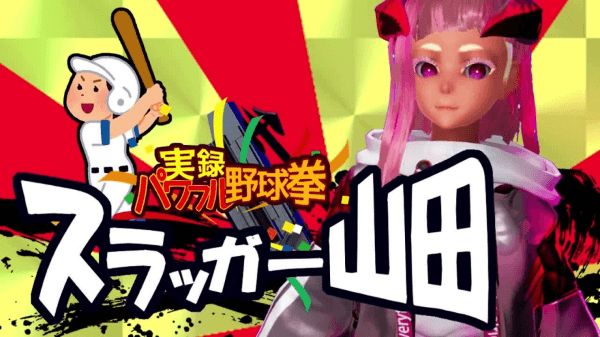
One of the few perks of being raised in an appendage of the British Commonwealth is that I have but a cursory knowledge of baseball: it’s like tee-ball minus the tee; Jose Canseco’s insane; Don Mattingly’s sideburns were out of control; games last roughly nine years apiece; beyond that, ya lost me. Is it more or less tedious than cricket? Perhaps the world will never know, but one thing is for certain: solo dev Digimeca Seisakusho’s shitpost gumbo 実録パワフル野球拳スラッガー山田 (Jitsuroku Powerful Yakyuuken: Slugger Yamada) captures the truest essences of the sport, and I feel confident in stating that it has done more to elevate the credibility of baseball in 2023 than any other event or individual that one might care to name.
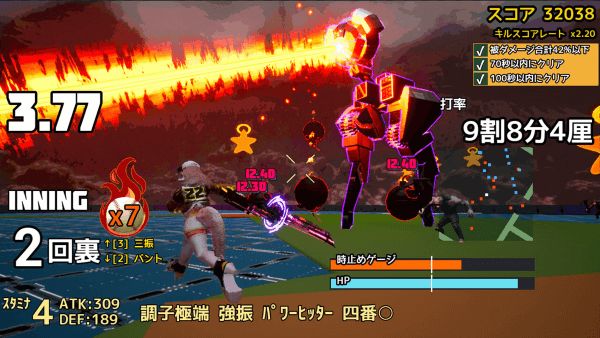
It's not as complicated as it looks, trust me.
Slugger Yamada is a 3D action game puts the player in control of 13-year-old Yamada Surakko, the last living successor of the ancient martial art of Yakyuuken who has decided to take on the entire world with her dimension-defying techno-bat in the hopes of proving herself as the world’s most powerful being. Naturally, this requires the player to run across a variety of open 3D stages, beating the life out of all manner of strange foes in order to reach the goal point of the stage, or simply to survive: clearing stages unlocks more stages to play from the main menu, and as the player’s per-stage rankings and cumulative total score hits certain milestones, they’ll be able to apply stat upgrades to Yamada, unlock new moves and mechanics and more.
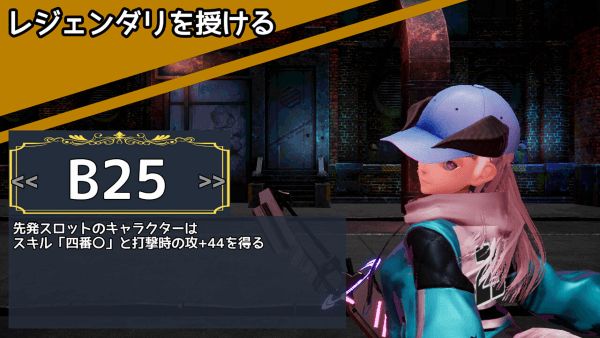
Various new outfits for Yamada can be found by breaking objects in each stage.
Being that Yakyuuken is a baseball-centred discipline, Yamada routinely cycles between a batting stance, which allows her to attack enemies at close range with strikes and to deflect enemy projectiles, and a pitching stance, which sees her gun transform into a projectile weapon that can be used to attack foes from a distance or destroy items in hard-to-reach places. A full cycle of batting and pitching is counted as an inning, and Yamada can only play so many innings in a single run before automatically failing the stage, so right from the get-go, the game presents a strategic layer of properly managing your innings to make sure you can successfully complete a stage. Furthermore, Yamada possesses a time-slow ability that is governed by the yellow on-screen time-stop gauge and is automatically applied to every attack until the gauge is drained. Not only does this ability slow time on contact, allowing the player ample time to counter-attack or react to enemies, it also allows you to build up a damage multiplier by landing multiple hits in succession, which leads the player to making tactical decisions about where to maximise the value of the time stop and whether to manually switch stances and sacrifice time on the clock in order to refill the time-stop gauge.
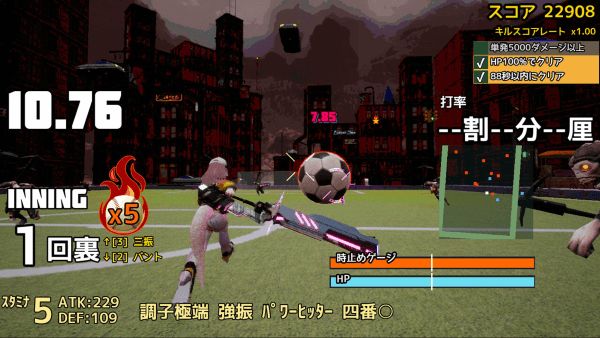
From time to time, Yamada sets her sights on other ball sports.
Over time, the player will be able to use their accumulated training points to selectively improve Yamada’s various stats, which will eventually confer additional passive buffs once they’ve reached a certain rank, as well as gain access to useful special moves that can be accessed by manually switching stances (like the ever-useful bunt, interpreted here as a whirling cyber-frenzy that reliably deflects anything in its vicinity). Eventually, you’ll unlock the game’s big secondary mechanic: 遊☆具☆王 (Yu-Gu-Oh), a deck-building system that sees the player constructing a 6-card deck of “support players”, equipment and single-use buffs that will significantly enhance Yamada’s abilities during a run—each card has a “stamina” value that determines how long it can be active. So assembling a deck is not just a matter of picking unilaterally advantageous cards but of specifically choosing cards in accordance with the design of each stage that can be maximally utilised in sequence, or that a more reckless player might want to gamble on via one big play… y’know, like selecting the line-up for a baseball team, or so I’m led to believe. These cards are earned via a gacha system based on in-game crystal currency; there aren’t a ton of cards to collect and the game’s quite generous with crystals, so unless you decide to speedrun the game, I can’t imagine it’ll present as particularly annoying.
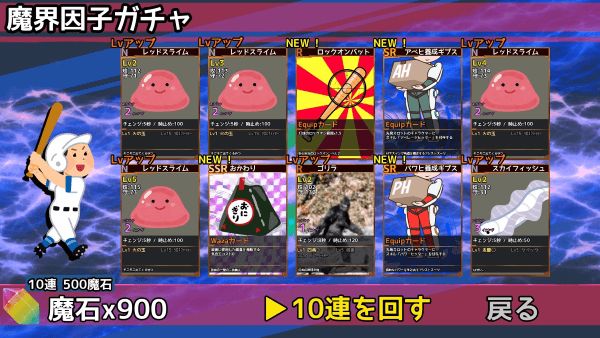
Speedrunner Sean_A has compiled a translated list of all the cards and their effects, should you require it.
Reading all these descriptions of interlocking systems might leave you thinking that Slugger Yamada is designed specifically for hardcore melee action fiends, but that couldn’t be further from the truth: the game doesn’t demand a lot of mechanical execution, nor is it especially difficult, save whatever road blocks appear as knowledge checks for certain system mechanics. Indeed, a lot of the stages make it quite easy to ignore most of the enemies and beeline for the end goal if you really want to; the fun comes not from merely clearing each stage but for concocting a strategy to maximise all your multipliers and use all your cards as efficiently as possible to completely steamroll all the “hard” parts and rack up big scores. This isn’t Devil May Cry, or a Musou game, or even Oneechanbara—the very compartmentalised, unadorned, puzzle-ish stage design reminds me more of Treasure’s Bangai-O series, if anything.
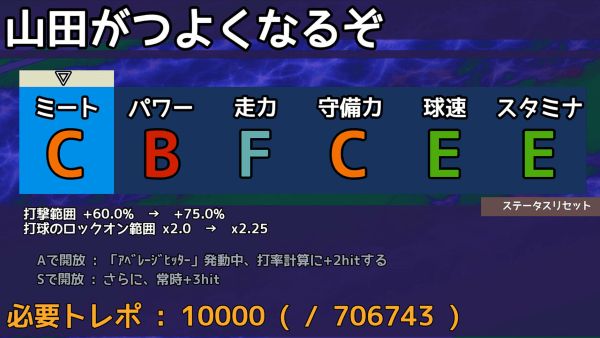
The attribute upgrade screen, designed to evoke a similar screen from a certain other famous Japanese baseball video game.
That comparison also applies to the game’s setting and tone—which, like Bangai-O, is not only highly irreverent but almost disdainful of the idea that you might ever deign to take it seriously. Every line of dialogue between Yamada and her bat’s AI avatar is willingly inane; the mission briefings are all full of silly gags (like a warning about a ninja sniper ambush that the ninjas were legally obliged to share on LINE), and even the menus exist as knowing sendups of other games and properties. (The very concept of a baseball-themed martial art is a riff on SNK’s little-played fighting game Savage Reign, even.) This absurdity is brought to another level via the game’s near-universal reliance on publicly-sourced assets: not only did the developer lean into using all manner of easily-identifiable models, sounds, and illustrations, but they correctly identified that this approach needn’t necessarily project the semiotics of a student project, or a cynical clone of an existing game, or an ironic veneer for a concept they’re not willing to present in a sincere manner; but that presenting left-of-centre ideas through the prism of stock assets makes them more digestible, and that applying these assets with the right touch is enough to very quickly quash any concerns about a lack of ambition, or ability, or whatever. I mean, why shouldn’t the sentry cannons fire giant rotating shark models instead of rockets? What original illustrations could possibly serve for better CCG fodders than Irasutoya and that one grainy-ass photo of Bigfoot? Any specialised menu graphic they might have drawn would probably disappear from my memory the moment I stopped playing, but the image of the player-character inching uncomfortably close to the camera while doing the macarena is bound to stick with me forever.
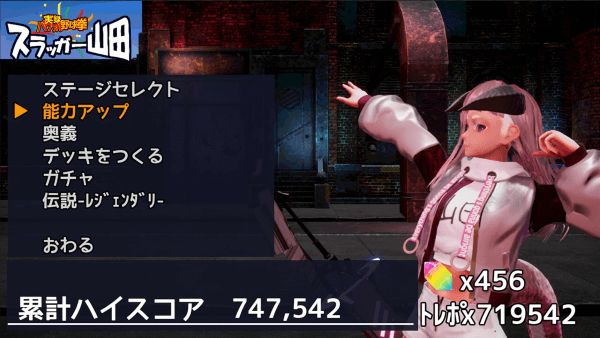
Yamada, seen here in the middle of one of any number of extremely-played-out dance moves.
You’ll have seen everything Jitsuroku Powerful Yakyuuken: Slugger Yamada has to offer after a few hours, but if you’re anything like me, you’ll be left with plenty to ponder: how might this format expand to include more enemies, bosses and gimmicks? Will Gunma ever stop being a punching bag? Is baseball fun, actually? If we’re lucky, Digimeca will be back with another near-identical game using most of the same assets by this time next year, and I’ll be there day one.

